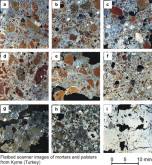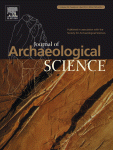| New Volume/Issue is now available on ScienceDirect |
| | Original Research Articles | |
| | 4. | The abrasion of modern and archaeological bones by mobile sediments: the importance of transport modes Original Research Article
Pages 784-793
C.E.L. Thompson, S. Ball, T.J.U. Thompson, R. Gowland
Research highlights► Accurate modelling of sediment transport processes is essential.► Sediment transport modes affect degree and type of wear seen.► Degree and type of wear is dependant on bone age.► An asymptotic increase in wear occurs with duration of exposure.► Wear to bone from mobile sand sized sediments is characterized by deformation wear.
| |
| | 5. | Characterisation of archaeological mortars and plasters from kyme (Turkey) Original Research Article
Pages 794-804
Domenico, Miriello | Andrea, Bloise | Gino M., Crisci | Carmine, Apollaro | Antonio, La Marca
Graphical abstract
Research highlights► The present study focuses on the characterisation of plasters and mortars from Kyme.► Compositional differences were found between the samples.► Regards the Roman mortars no samples made only of natural pozzolanas have been found.► Analysis of the binder pointed out that natural slaked lime was used in Kyme.► The lower quality mortars belonged to the Medieval period.
| |
| | 6. | Ancient bronze technology and nomadic communities of the Middle Gobi Desert, Mongolia Original Research Article
Pages 805-817
Jang-Sik Park, William Honeychurch, Amartuvshin Chunag
Research highlights► Bronzes of the Xiongnu and earlier period from Mongolian Gobi were examined. ► They consist of objects representing the entire bronze manufacturing process. ► Shift in major alloying elements from As to Sn and Pb was observed with time. ► This shift in bronze tradition may reflect changes in inter-regional interaction.
| |
| | 7. | Archaeometric study of medieval pottery excavated at Stari (Old) Ras, Serbia Original Research Article
Pages 818-828
Ljiljana Damjanović, Ivanka Holclajtner-Antunović, Ubavka B. Mioč, Vesna Bikić, Dragan Milovanović, Ivana Radosavljević Evans
Research highlights►A multianalytical study of medieval pottery excavated in the archaeological area Stari Ras, Serbia. ►Thin-section petrography, ICP-MS, PXRD and FTIR spectroscopy have been used. ►Two groups of samples have been clearly distinguished by applied methods: Ras and Reljina Gradina. ►Reljina Gradina is of local origin and production; Ras is likely to be imported. ►Firing temperature for both groups of samples can be estimated as 800–900 °C
| |
| | 8. | Interpreting, dating, and reevaluating the botanical assemblage from tell Kedesh: a case study of historical contamination Original Research Article
Pages 829-842
Ksenija Borojevic
Research highlights► AMS dates of floated charred plant macro remains differ from those of archaeological material. ► Cannot assume the age of charred plants are ancient and they must be dated directly. ► Depositional and postdepositional processes involve serious mixing throughout. ► Bioturbation by small animals (e.g. harvester ants) has to be further investigated. ► Future research must combine palaeoethnobotany and soil micromorphology with direct AMS dating.
| |
| | 9. | Order in movement: a GIS approach to accessibility Original Research Article
Pages 843-851
M. Llobera, P. Fábrega-Álvarez, C. Parcero-Oubiña
Research highlights► Landscapes become structured when moving towards a specific destination. ► GIS calculated accumulated cost surface provides an _expression_ of this structure. ► A focal mobility network describes most likely paths to destination. ► Movement is characterized by accessibility signatures, indexes and mobility basins. ► Accessibility for NW Spain Iron Age hillforts from different periods are compared.
| |
| | 10. | Points and prey: a quantitative test of the hypothesis that prey size influences early Paleoindian projectile point form Original Research Article
Pages 852-864
Briggs Buchanan, Mark Collard, Marcus J. Hamilton, Michael J. O’Brien
Research highlights► We tested the hypothesis that prey size influenced the form of Paleoindian points. ► Standard and geometric morphometric data were recorded on Clovis and Folsom points. ► We used points only associated with mammoth or bison remains. ► Points used to hunt mammoth were found to be different than those used to hunt bison. ► When point type and prey size were analyzed, the results ran counter to predictions.
| |
| | 11. | Debitage variability among multiple flint knappers Original Research Article
Pages 865-872
Justin P. Williams, William Andrefsky Jr.
Research highlights►We analyzed the debitage created by both the production of early stage bifaces and multidirectional core reduction of five different flint knappers. ►This experimental study demonstrates that different flint knappers produce different sized debitage. ►One of these five knappers produces distinct debitage when reducing multidirectional cores. ►We demonstrate that knappers produce different frequencies of proximal flakes, flake shatter and angular shatter.
| |
| | 17. | Stable isotope analysis of a medieval skeletal sample indicative of systemic disease from Sigtuna Sweden Original Research Article
Pages 925-933
Anna Linderholm, Anna Kjellström
Research highlights►The diet and origin of individuals showing systemic disease and unaffected individuals was analysed. ►Diet and origin was analysed using carbon, nitrogen and sulphur isotope analysis. ►The results showed no difference between the two groups, but did show dietary differences to a previous study of high-status individuals. ►The affected, though low-status judging by historic sources and burial practice, show no dietary segregation. ►The results from the present study highlight the hierarchical arrangements of social classes in the early medieval society.
| |
Access the ScienceDirect Info site if you have questions about this message or other features of this service.
|

|





